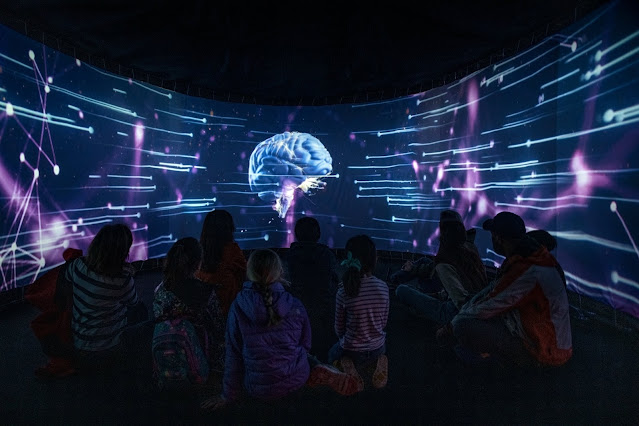Welcome to my latest blog entry, a space where the artistry of Santiago Ramón y Cajal, the legendary Spanish Neuroscientist, becomes the muse for a unique fusion of science and art. As an artist, professor, and Fulbright Scholar, I have the privilege of exploring and breathing "the life" of Cajal's intricate scientific sketches within the four walls of my studio. Just as the swirling hues of a nebula inspire the astronomer, the delicate complexities of Cajal's drawings breathe inspiration into my work.
Monday, June 19, 2023
Threaded Pathways: Unraveling Neuroscience and Art in Hannah Warming's Needles & Neurons
Thursday, June 8, 2023
Exploring the Wonders of the Human Brain: A Journey through Science and Art at the Madrid Book Fair
The 82nd Madrid Book Fair, spanning the duration of two weeks (May 26-June 11, 2023), is welcoming visitors with a multitude of booths representing nearly 1,000 publishing houses across 424 exhibitors. This year's event has undergone modifications aimed at redesigning specific areas to enhance the accessibility of books and alleviate congestion. One noteworthy addition is the implementation of the "shadow project," whereby select sections of the fairgrounds will be covered with tarps. This initiative has been made possible through the support of the Healthy Skin Foundation of the Spanish Academy of Dermatology and Venereology.
Another departure from the Madrid Book Fair tradition is the omission of the customary "Guest Country" designation, which has been replaced by the overarching theme and motto:
"We're into Science and Letters" [#DeCienciasYLetras]
In line with this new approach, exploring scientific literature, many activities are organized to include an established "Science Square" that serves as a collective epicenter of the fair. Among the notable attractions within this area is a projection of a giant brain, coinciding with the Año Cajal, created by CSIC Divulga, provides insights into the intricacies of neuronal functioning.
 Left, my drawing of Cajal's sketchbook page of dividing skin cells and right, the Cajal's published finished drawing of dividing skin cells from his textbook: Manual de Histología Normal y de Técnica Micrográfica par Uso de Estudiantes
Left, my drawing of Cajal's sketchbook page of dividing skin cells and right, the Cajal's published finished drawing of dividing skin cells from his textbook: Manual de Histología Normal y de Técnica Micrográfica par Uso de EstudiantesThe opening discourse of the Madrid Book Fair, aligned with the overarching science theme of this edition, will be delivered by Agustín Fernández Mallo, an esteemed writer, in collaboration with Nazareth Castellanos, a doctor of Neuroscience, and Andrés Newman and Raquel Lanseros, both of whom have demonstrated a particular interest in scientific matters through their literary works. Furthermore, various gatherings, experiments, and panel discussions revolving around science will be held in the Children's Pavilion, the CaixaBank Pavilion, and the Eugenio Trías Library. These events, many of which are organized by the CSIC and the Spanish Foundation for Science and Technology, aim to foster engagement with scientific topics.
Recognizing that science permeates our daily lives, the Madrid Book Fair endeavors to bridge the gap between scientific knowledge and the general public. In this context, activities explore diverse manifestations we encounter, like the metadata that impacts cyber algorithms that shape our social networks and our individual and collective identities. Other presentations of contemporary existence, such as emerging artificial technologies, have showcased how art is integrated into our lives through scientific illustrations. To that end, the Madrid Book Fair welcomed esteemed guests, including Alejandro Vergara Sharp, the head of the Conservation Area of Flemish Painting and Northern Schools at the Prado Museum, and José Ramón Marcaida, the Head Scientist of the History of Science Department at the CSIC History Institute. Together, these two experts shed light on the captivating interplay between art and science during the 15th and 16th centuries, revealing key insights into this dynamic relationship. Other experts specializing in diverse fields will offer insights on the intersection of scientific and literary subjects on the pavilion for Science and Universities.
A riveting exhibit at the Madrid Book Fair, introduced above, is the enthralling exhibition that explores one of science's most enigmatic marvels: the human brain. This exhibit dovetails with the Año Cajal and examines the intricacies and allure of the brain and the exhibition examines the complexity of the human mind. This installation embodies a unique and immersive experience that is captivating to the viewer and is a testament to the symbiotic relationship between science and art.
Citing Cajal's legendary scientific and artistic endeavors, the exhibition draws visitors into a realm where science and creativity intertwine. The display aims to foster a dialogue between scientific discovery and artistic expression through a multidimensional exploration that provides a gateway to a deeper understanding of the enigmatic nature of our cognition.
Through its immersive and visually striking presentation, the exhibition evokes wonder and curiosity - inspiring future generations of researchers and creatives. As spectators traverse the exhibition, they will witness the intricate tapestry of neural connections, gaining insight into history and the inner workings of human consciousness and explore the potential of the future through new technologies and groundbreaking innovations. Guests can obtain passes and schedule a visit to the exhibition on CSIC's website: here
As is customary, many authors are scheduled to attend the fair and will be signing copies of their books. This year the Madrid Book Fair will present a selection of prominent figures and authors whose works have achieved widespread acclaim and garnered substantial demand. This year's fair will pay tribute to literary giants Jorge Luis Borges, Antonio Gala and Juan Benet on Friday, June 8, 2023.
More Information
The 2023 Madrid Book Fair runs from May 26-June 11 at El Retiro Park.
Book Fair hours are:
- Monday-Thursday, 10:30 am to 2:00 pm & 5:00 pm to 9:00 pm.
- Saturdays and Sundays, 10:30 am to 3:00 pm & from 5:00 pm to 9:00 pm.
- The closest Metro Madrid stations are Príncipe de Vergara (Lines 2 and 9), Ibiza (Line 9), and Retiro (Line 2).









